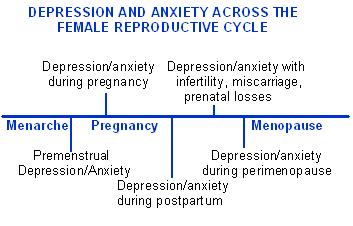Between puberty and menopause women are twice as likely as men to be anxious or clinically depressed. This vulnerability has been found in multiple countries and ethnic groups and is not just due to socio cultural factors.
Differences in men and women are:
• Frequency of depression and anxiety
• Types of depression and anxiety
• Associated conditions
• Responses to stress
• Types of stress
• Duration and severity of symptoms
• Preferred medications
• Dosages of medications
• Role of hormones
Symptoms in women are especially prominent premenstrually, during pregnancy, post partum and perimenopausal. Dropping levels of estrogen cause symptoms in susceptible women. Menopause has not been found to be a period of increased risk for depression.
The role of hormones (estrogen, progesterone, DHEA, and testosterone)and brain transmitters (serotonin and GABA) have been extensively studied. All of these factors guide the treatment.
More than half of all adults will experience a significant stress disorder in their lifetime. Clinically depressed men and women are very likely to have other concurrent stress disorders. Women most commonly have anxiety and eating disorders. Men are more likely to have alcohol or substance abuse.
Women are three times as likely as men to have seasonal affective disorder. This is a common form of depression referred to as “atypical” because instead of the normal symptoms of depression, loss of appetite, weight decrease, inability to sleep and blunting of normal feelings, in atypical depression they tend to overeat, gain weight, sleep excessively, overreact emotionally, feel rejected, and may have a feeling of “leaden paralysis.” It is as though they have gone into a hibernation state. Since seasonal depression most likely occurs in the winter, there is probably an underlying adaptive mechanism that gets activated.
In general, women are more reactive to stress and are more stressed by problems associated with family and home. Men are more stressed by issues with work and finances. Men are also more likely to respond to stress by taking action, or increasing physical activity. Women tend to seek social support and are more likely to internalize conflict. This can cause women to develop physical symptoms of illness. These include low thyroid, chronic fatigue, irritable bowel, migraine, pain, interstitial cystitis, and fibromyalgia.
Women are more likely than men to seek help for their symptoms, but men are becoming more aware of the effects of stress on functioning and quality of life. There is an old TV ad where a mechanic holds up a can of engine additive for cars and says, “you can pay me now or you can pay me later.” In women as well as men the earlier the recognition of symptoms and the better the patient education and treatment, the less the suffering, long term complications and the higher the quality of life. The goal of complete remission of symptoms and return to full functioning can usually be achieved through collaboration between the patient and the PCP and/or psychiatrist.

